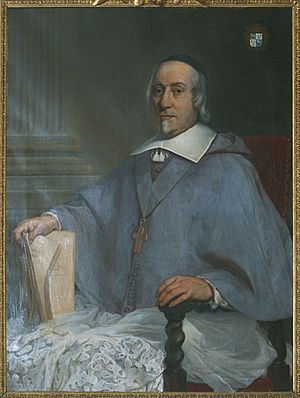Pierre de Marca facts for kids
Pierre de Marca (born January 24, 1594 – died June 29, 1662) was an important French leader. He was a bishop in the Catholic Church and also a historian. He was born in Gan, a town in France, and came from a family known for their work in law.
Quick facts for kids His Grace Pierre de Marca |
|
|---|---|
| Archbishop of Paris | |

Engraving by Gérard Edelinck, 1696
|
|
| Church | Roman Catholic Church |
| Archdiocese | Paris |
| See | Notre-Dame de Paris |
| Enthroned | 5 June 1662 |
| Reign ended | 29 June 1662 |
| Predecessor | Jean François Paul de Gondi |
| Successor | Hardouin de Péréfixe de Beaumont |
| Other posts | Archbishop of Toulouse Bishop of Couserans |
| Personal details | |
| Born | 24 January 1594 Gan, Béarn, Navarre |
| Died | 29 June 1662 (aged 68) Paris, France |
| Nationality | Navarrese |
| Spouse |
Marguerite de Forgues
(m. 1618) |
| Alma mater | University of Toulouse |
Contents
Early Life and Career
Pierre de Marca's family was well-known in the 1500s for their work in the legal system. They remained loyal to the Roman Catholic faith. This was important because the Protestant religion had become official in Navarre. Pierre studied law at the University of Toulouse. He then worked successfully as a lawyer in Pau. However, he had bigger goals for his career.
He strongly supported King Louis XIII's plan to intervene in Béarn. In 1618, he wrote his first paper. It was called Discours d'un Béarnais. This paper supported Catholicism as the main state religion. After a quick military campaign in 1620, properties taken by the Protestants were returned to the Catholic Church. Marca helped manage this return of church properties.
Working with Richelieu
During the siege of La Rochelle, Pierre de Marca carried out a special task. This task connected him with Cardinal Richelieu. Richelieu was a very powerful figure in France. Soon after, Richelieu appointed Marca as a special administrator in Béarn in 1631.
In 1639, Marca was called to Paris. He became a counsellor of state, advising the government. The next year, a debate started about kings' roles in choosing bishops. Marca wrote a famous book called De concordia sacerdotii et imperii. This book defended the independence of the Gallican Church in France. He was soon rewarded for his work. Around this time, his wife passed away. Marca then decided to join the church as a clergyman.
Becoming a Bishop
Even though Marca had not yet become a priest, the king chose him to be the bishop of Couserans in 1641. However, Pope Urban VIII did not approve this choice. It was only after Marca formally changed some of his views from his book De concordia that the Pope approved him. This happened in 1648.
From 1648 to 1651, Marca also served as governor of Catalonia. This region was then under French control. After the Treaty of the Pyrenees in 1659, Marca helped lead a meeting. This meeting was to decide the borders of Roussillon, which France had just gained.
Archbishop of Toulouse and Paris
Marca became a close ally of Cardinal Mazarin, another powerful French leader. He remained loyal to Mazarin during a civil war called the Fronde. As a reward, Marca was chosen to be the archbishop of Toulouse in 1652. He had to wait until 1654 for the Pope's official approval.
It was often hard for Marca to please both the Pope and the King. He used his influence to support a church rule against the Jansenists. But when Cardinal de Retz, the archbishop of Paris, rebelled against the king, Marca sided with the king. This was against the Pope's wishes.
Michel Le Tellier asked Marca to argue against the idea of the Pope being infallible. Marca wrote a paper that strongly supported the French church's independence. But he chose not to publish it. He feared it would anger Rome. This strategy worked. When Cardinal de Retz resigned as archbishop of Paris, Marca was chosen to replace him in 1662. Sadly, Marca died in Paris on June 29, 1662. He passed away before the Pope could approve his new role as archbishop of Paris.
Historian and Writer
From a young age, Marca was very interested in the history of his home region. In 1617, at just 23 years old, he started looking through old records. He copied important documents and wrote to other scholars. His book, Histoire de Béarn, was published in Paris in 1640. It was not as popular at the time as his church writings. However, it is now seen as a very important historical work.
Marca's historical research was careful. He always presented the original texts correctly. Many chapters in his book end with interesting collections of old documents. It is a pity that this work is not complete and only covers history up to the year 1300.
During his time in Catalonia, Marca also did research for a book about that region. Etienne Baluze, who became Marca's secretary in 1656, helped him finish this work. Baluze added more information and published it in 1688. The book was called Marca hispanica.
Family Life
Pierre de Marca married Marguerite de Forgues on June 4, 1618. They had one son and three daughters. Their son, Galactoire, became president of the parliament of Navarre. He died in 1689.
Biographies and Other Works
Two biographies of Marca were written in Latin by his close friends. Baluze, his secretary, wrote one in 1663. His cousin, Paul de Faget, published another biography in 1668. Faget's collection also included some of Marca's religious writings. These writings caused some controversy. Baluze and Faget later argued with each other while trying to defend Marca's memory.
See also
 In Spanish: Pierre de Marca para niños
In Spanish: Pierre de Marca para niños

